Deborah Swift's Blog
September 8, 2025
Astrology and Medicine in the Renaissance #BlogPost #GiuliaTofana
The third book in my Italian Renaissance series, The Fortune Keeper, begins the story of Girolama Spera, Giulia Tofana’s daughter, and a real historical person who was also accused of poisoning a generation of men, by following in her mother’s footsteps.
She was known as ‘The Astrologer’ – hence the title of the book. At the beginning of the book, Girolama (nicknamed in my book Mia, to avoid confusion with her mother, Giulia) is embarking on her study of astrology with Bravaggio, an astrologer who is much influenced by the work of Galileo.
Astrology in the time of Galileo
‘Astrology in seventeenth century England was not a science. It was not a Religion. It was not magic. Nor was it astronomy, mathematics, puritanism, Neo-Platonism, psychology, meteorology, alchemy or witchcraft. It used some of these as tools; it held tenets in common with others; and some people were adept at several of these skills. But in the final analysis it was only itself: a unique divinatory and prognostic art embodying centuries of accreted methodology and tradition’ – Science Historian Ann Geneva
This statement was as true for Renaissance Italy as it was for England. Astrologers of the Italian nobility, for example Ficino and his patrons the Medicis, would use horoscopes to determine the fate and future of people, events and new projects. Men we regard as bastions of science now, such Kepler or Galileo, were actually practicing astrologers at this time.
Astrology has always been blurred with astronomy, with the search for human meaning in the sky; the desire to look to the stars and planets for answers to the mysteries of human life. In medieval Europe astrology was used in the universities in the seven so-called liberal arts which were each allied to a planet. The arts of astrology and astronomy, which were largely conflated together, were assigned to Saturn.
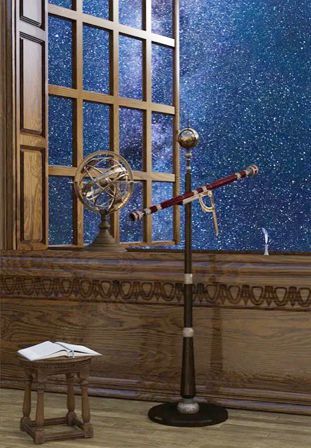
In the 17th Century the invention of the telescope (formerly known as a spy-glass) changed the world view and completely undermined one of the purposes of astronomy – the casting of horoscopes. The idea of the horoscope relied on the belief in a fixed Earth which was always to be central in the Christian view of Creation. The lens of the telescope revealed the vastness of space and that there were infinite stars and planets invisible to the naked eye.
In January 1610, Galileo made a startling discovery using one of the new telescopes. He was able to observe the moons orbiting Jupiter. His subsequent book, Siderius Nuncius (Starry Messenger) which describes this, rejected the old Earth-centred idea of the universe, and also the long-held doctrines of the Catholic Church. Galileo became a cultural martyr to this new cause, that of the earth in movement around the sun, and his ideas were condemned as heresy by the Catholic Inquisition.
In June 1633, He was declared guilty of and made to recite and sign a formal confession:
‘I curse and detest the said errors and heresies, and generally all and every error, heresy, and sect contrary to the Holy Catholic Church.’
Tradition, but not historical fact, holds that, after abjuring, Galileo mumbled the contradictory opinion; ‘Eppur si muove’ (And yet still it moves).
Astrology for Dog Bites and Broken Hearts
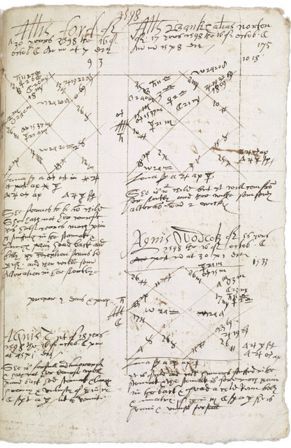 A page from Simon Forman’s casebook
A page from Simon Forman’s casebookfor 16 October 1598. MS Ashmole 195, f. 175r.
Copyright Bodleian Library, University of Oxford, 2018.
Two physicians of 17th-Century England left behind an expansive archive of 80,000 patient records which were gathered together in 66 calf-bound volumes. Volumes such as this must also have been common in Italy, where astrology was taught as part of the medical training of physicians at the University of Padua.
‘thousands of pages of cryptic scrawl full of astral symbols, recipes for strange elixirs, and details from the lives of lords and cooks maids suffering with everything from dog bites to broken hearts,’
(Professor Lauren Kassell from Cambridge’s History and Philosophy of Science department.)
A team of researchers from Cambridge University have now finished the fascinating task of sifting through these scribbled notes and astrological diagrams to digitize their findings, and they are now housed in a library known as The Casebooks Project.
Such was the acceptance of astrology in this era that Ficino, when asked for advice by the King of Hungary in 1489, recommended entrusting his health to doctors and astrologers who study the stars for cures since this is ‘science and common sense’.
Astrology on your Hat
Here is the beautiful Arundel Jewel, which, though made in 16th Century for the Duke of Mantua, shows the Zodiac just as we know it today. It is believed that this rare and precious jewel was once worn as a hat ornament, and not as a simple pendant as seen here. I can’t imagine wearing something so precious where it might get lost or easily stolen by someone grabbing your hat!
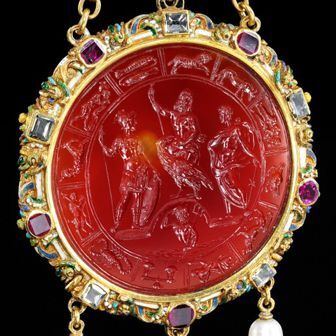
The Arundel Zodiac is a rare 16th-century intaglio carved with Jupiter astride an eagle, flanked by Mars and Mercury, and Neptune underneath. The composition is encircled by a frieze with the signs of the Zodiac. Only three such Zodiac gems exist from the period – one in the State Hermitage Museum, St Petersburg, one in the French royal collection; and this one. On the back of this gem is a stunning depiction of a crane set amongst exotic flowers. The vibrantly enamelled crane likely serves as a representation of the spirit rising from the terrestrial world
Astrological beliefs were not exclusive to the educated and the rich upper classes, but through the culture of Renaissance Italy reached right down to the lower levels of society. The astronomer Bartolomeo on completion of the astrological clock tower in the Piazza Erbe, Mantua, said that it not only told people the time but also ‘the critical days in which infirmities are possible.’ If you’d like to know more, here is a short but stunning video from Sotheby’s about the jewel.
READ MORE:
Sources for The Casebook Project: Lauren Kassell, Michael Hawkins, Robert Ralley, John Young, Joanne Edge, Janet Yvonne Martin-Portugues, and Natalie Kaoukji (eds.), ‘Casebooks’, The casebooks of Simon Forman and Richard Napier, 1596–1634: a digital edition, https://casebooks.lib.cam.ac.uk
This title is available to read on #KindleUnlimited.
Universal Link: https://mybook.to/FortuneKeeper
Audiobook Buy Links:
Kobo: https://www.kobo.com/gb/en/audiobook/fortune-keeper-the
Audio: https://www.audible.co.uk/pd/The-Fortune-Keeper-Audiobook/B0C63R95WM
New Release! The Stars Over Rome by Charlotte Betts #Historical #Romance #Italy
I’m thrilled to highlight Charlotte Betts’ new release The Stars Over Rome. I’ve read all of Charlotte’s books and they never disappoint with their combination of excellent research, lush settings and romantic appeal.
Here’s the blurb:
In a world where women are often overlooked, can Gabriella defy expectations and carve out a place for herself in a rapidly changing society?
Rome, 1913
To her mother’s dismay, Gabriella Hazelwood has no interest in marriage or a quiet domestic life – not when she has big dreams of becoming a journalist. But when she meets Marco Santorelli, a handsome newspaper heir who believes in her ambitions as much as she does, Gabriella begins to wonder if she can have both a husband and a career.
Under the magical stars of Rome, their connection deepens, and a sweeping love story begins . . . until the shadow of war casts a dark cloud over Europe.
When Marco is called to the front, and his family’s newspaper teeters on the brink of collapse, Gabriella steps in to help, only to face fierce resistance from those who believe a woman has no place in the newsroom. As she fights to prove herself, tradition and progress collide, loyalties are tested, and the devastating consequences of war jeopardises all that she holds close to her heart.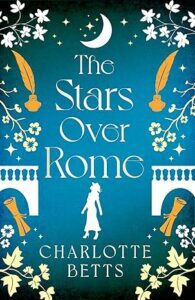 Why do readers love Charlotte Betts?
Why do readers love Charlotte Betts?
‘Lush, romantic and full of intrigue‘ Tracy Rees, Richard & Judy bestselling author
‘A deeply romantic novel whose vivid characters will linger in your mind‘ Margaret Kaine
‘A stunning and captivating read . . . full of drama, love, loss and life’ Book Literati
‘Lingers in the heart long after the final page is turned . . . a must read for anyone who wants to be absorbed as well as utterly enchanted‘ Carol McGrath
‘A compelling story, beautifully written and brought alive with rich historical detail‘ Liz Harris
BUY THE BOOK UKAbout Charlotte:
 Charlotte Betts began her working life as a fashion designer in London. A career followed in interior design, property management and lettings.
Charlotte Betts began her working life as a fashion designer in London. A career followed in interior design, property management and lettings.
Always a bookworm, Charlotte discovered her passion for writing after her three children and two step-children had grown up. Her debut novel The Apothecary’s Daughter won the YouWriteOn Book of the Year, the Romantic Novelists’ Association , the Joan Hessayon Award for New Writers and the RoNA’s Historical Category award, and she has gone on to win many more awards for her subsequent novels which have been translated into eight different languages.
You can find Charlotte online here:
www.charlottebetts.co.uk Twitter: @CharlotteBetts1 Facebook: Charlotte Betts – Author Instagram: charlottebetts.author
The post New Release! The Stars Over Rome by Charlotte Betts #Historical #Romance #Italy first appeared on Deborah Swift.August 7, 2025
Cairo Gambit by SW Perry #ARC #Review #Egypt
‘An enthralling thriller … hypnotically readable’ ANDREW TAYLOR
In the heat of the desert, will the trail go cold?
Cairo, 1938
Archie Nevenden is many things: amateur archaeologist; theatre impresario; absent father; potential defector. And now, he’s a missing person.
His daughter, Prim, hasn’t seen him for nearly fifteen years. But she’s never given up on him, and now she’s on her way to Cairo to assist in the search.
Harry Taverner claims to work for the British Council, but Prim knows there’s more to it. He clearly has a theory about what happened to Archie, one she’s not going to like.
As Prim and Harry uncover the layers of Archie’s existence in Cairo, they find themselves drawn in to more than one conspiracy. And soon they’ll discover that Archie may not be the only one in danger…
Praise for S W Perry:
‘Powerful, panoramic’ Sunday Times
‘Beautifully written, entirely convincing’ Leonora Nattrass
‘Gripping and heartfelt’ Elisabeth Gifford
‘Sweeping’ Daily Mail
July 28, 2025
Marguerite by Judith Arnopp #CoffeePotBookClub #QueenofEngland
I’m a big fan of Judith Arnopp’s books, so I’m delighted to host this excerpt from Marguerite! Hell Hath No Fury.
1443 – Having produced an heir for England, Marguerite returns to court, hoping for a warm welcome.
After an uneasy Christmas season, the new year sees the divisions at court widening and deepening. I am convinced the great fissure has grown so wide that it will never now be healed. The uneasy friendship that once existed has inflated into the blackest enmity. York is like a great chained beast that, once unleashed, will tear me to pieces. I am the Frenchwoman, the whore, and he has even begun a rumour that Prince Edward is not the king’s son. It is an easy lie to believe; one look at Henry is enough to convince any man the king is not capable of begetting a child, let alone a son.
As the day of the council meeting approaches, I prepare myself. I stand at my window and watch as the dawn slowly reveals a white sky; cold, yet showing no threat of rain or worse. I have them dress me in my finest, most regal robes, and enter the meeting to discover proceedings have already begun without me. A gentleman speaking halts mid-sentence when I enter, and all heads turn toward me. Heedless of my interruption, I take a seat hastily vacated by Warwick at the head of the table.
“Gentlemen. My apologies for my late arrival. I see my absence hasn’t delayed you.”
They bow and wait for my permission to be seated. I keep them standing for as long as I can before reluctantly indicating they may sit.
“Gentlemen,” I repeat, endowing them with a brittle smile. “My advisor and I have prepared a list of five articles for the immediate future. The king is still not completely well, his illness is lasting longer than we had hoped, but the royal physicians assure me he is showing great signs of improvement. Therefore, for a short time, the governing of the country can be safely undertaken by myself and the gentlemen listed in this document.”
York stands up, opens his mouth to interrupt, but I continue to speak, raising my voice a little, determined to make my point. In truth, several of my former supporters are uneasy; not at my ability to rule in Henry’s stead, but at the obvious effect such a move will have on the atmosphere at court, where enmities increase daily, forcing men to take sides. No man should be required to choose between the Queen and the Duke of York, whose lust for power knows no bounds. But it is York who should withdraw, not I.
In more civilised countries, the solution would be obvious. There is nobody better suited to protect the well-being of my husband and son than myself, the queen. York, however, does not agree. As soon as he can make himself heard, he snarls his dissention.
“That is ludicrous. No man in England will feel safe under the rule of a woman. As the king’s heir, it is clearly my duty…”
“But you are no longer his heir,” I interject coolly. “My son, the Prince Edward, is now heir, and I am perfectly equipped for the role of regent. My own mother ran my father’s affairs for many years …”
“The affairs of a duchy! This is England, we do things properly here. There is not a man present who will agree to such a thing.”
I swallow my fear that he might be right. He will know that my allies, given the opportunity, will completely oust him from power. I school my expression to one of supreme confidence.
“You have not even glanced at the document, my lord. Perhaps you should do so and then we can continue with the day’s business.”
He snatches the parchment from the table and scowls at it, smacks it with the back of his fingers.
“This is preposterous nonsense. She demands the rule of the country, the right to appoint all officers of the realm, including the bishoprics! As you can imagine, that would leave many of us kicking our heels in the country while she turns England into another territory of France.”
I lean forward with my brows lowered.
“I would do no such thing. I am the Queen of England; the realm, the king and his heir are of supreme importance to me. I have no loyalty to France.”
He tosses the carefully drawn paper onto the table.
“I don’t know why you took the time and trouble to have such nonsense set to parchment. There are few here who will vote in your favour. Your role as queen I will grant you, but that role requires nothing more than the production of heirs. I suggest you see if you can rouse the king enough to give you one, if indeed it was he who sired your son.”
A gasp runs around the gathering. Even I am taken aback. Buckingham stands up.
“You speak treason, York, and defame your king! I demand an apology.”
I turn my head slowly toward Buckingham; it has not escaped my notice that he speaks out in defence of the king’s virility, but fails to defend my virtue. But York, knowing he has overstepped the mark, backs down.
“Forgive me, Gentlemen, I was too hot. I beg pardon.”
Again, I do not miss that he has omitted me from his apology.
“I suppose we must take a vote on it though,” he says. He reads slowly through the list of articles, his bored voice making no secret of how he expects his adherents to vote. “Those who are for, raise your hands.”
A few hands wave in the air; those I expected to cast in my favour.
“Those against?”
A bristling of fingers, as aggressive as spears, puts an end to my aspirations as Protector. Sickness washes over me, hatred and frustration that lies in my belly as bitter as poison. Without speaking, I stand up and quit the company and, as I hurry away, the sound of their derision follows me, the cruel masculine ridicule for a woman who has attempted to step from her allotted place.
God damn them all.
Marguerite: Queen of EnglandFrom the moment Henry VI’s new queen, Marguerite of Anjou, sets foot on English soil she is despised by the English as a foreigner, and blamed for the failures of the hundred years war in France. Her enemies impede her role as the king’s consort and when Henry sinks into apparent madness, her bid to become regent is rejected. Marguerite must fight, not only for her own position but to maintain Henry’s possession of the crown.The ambitious Duke, Richard of York, seizes control of the country, thrusting Marguerite aside and inflating the mutual hatred between the houses of York and Lancaster. But the queen refuses to relinquish power and fights determinedly for the rights of her son, Edward of Lancaster.The long and bitter civil conflict, that has come to be known as the War of the Roses, commences.
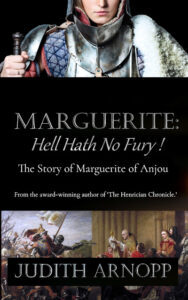
July 20, 2025
A Mischief of Murder by Helen Hollick #CosyMystery #CoffeePotBookClub
Today, I’m delighted to host A Mischief of Murder by Helen Hollick.
About the BookA Mischief of Murder is the sixth Jan Christopher Cosy Mystery
The village Flower and Veg Show should be a fun annual event – but who added mischief and murder to the traditional schedule?

Old friends and new enemies? Jan Christopher’s Aunt Madge is to be a judge at Chappletawton’s annual village flower and vegetable summer show – a chance for the family to have a holiday in the Devon countryside, especially as Jan’s fiancé, DS Laurie Walker, is still recovering from gunshot wounds and her uncle, DCI Toby Christopher, is enduring injury-related sick leave.
The event should be a fun occasion where friendly rivalry between gardeners, cooks and crafters leads to the hopeful winning of the coveted Best In Show trophy – but who added mischief and murder to the traditional schedule?
Praise for the Jan Christopher Mysteries:
“A delight—Miss Read meets The Darling Buds of May, with a dash of St. Mary Mead. Helen Hollick’s signature voice shines throughout, full of warmth and wit. The characters keep growing in such satisfying ways, making every visit feel like coming home.”
Elizabeth St.John
“The Darling Buds of May …but in Devon instead of Kent.”
Alison Morton
“I sank into this gentle cosy mystery story with the same enthusiasm and relish as I approach a hot bubble bath, and really enjoyed getting to know the central character, a shy young librarian, and the young police officer who becomes her romantic interest. The nostalgic setting of the 1970s was balm, so clearly evoked, and although there is a murder at the heart of the story, it was an enjoyable comfort read.”
Debbie Young, author of the Sophie Sayers cosy mysteries
“A delightful read about a murder told from the viewpoint of a young library assistant. The author draws on her own experience to weave an intriguing tale.”
Richard Ashen – South Chingford Community Library
“I really identified with Jan – the love of stories from an early age, and the careers advice – the same reaction I got – no one thought being a writer was something a working-class girl did! The character descriptions are wonderfully done.”
Buy Links
https://mybook.to/MischiefOfMurder
This title is available to read on #KindleUnlimited.
Excerpt from A Mischief of Murder
Snippet 1:
Beyond illustrations and photographs in books, I had no recollection of ever seeing the incredible Neolithic monument of Stonehenge, although as we parked the car and walked across the expanse of grass towards the huge standing stones, Aunt Madge informed me that I had been here before.
She elaborated as she fished her camera from its leather carry case, and inspected the lens settings. “You were only just two years old. We were a merry party, you, your twin sister June, your mother and me.” She started snapping photos of the stones as she spoke. “I’d offered to drive down to the wedding. Mind, it was February and bitter cold. Even the underwear your mother had knitted didn’t do much for the ice chills whipping up our skirts.” She laughed as she took another photograph. “My goodness, but the woolly knickers and vest itched! I recall my skin was red raw by the time we reached our hotel. I dropped the darn things straight into the bin, I can tell you!”
About the Author
Known for her captivating storytelling and rich attention to historical detail, Helen’s historical fiction, nautical adventure series, cosy mysteries – and her short stories – skilfully invite readers to step into worlds where the boundaries between fact and fiction blend together.

Helen started writing as a teenager, but after discovering a passion for history, was initially published in 1993 in the UK with her Arthurian Pendragon’s Banner Trilogy and two Anglo-Saxon novels about the events that led to the 1066 Battle of Hastings, one of which, The Forever Queen (USA title – A Hollow Crown in the UK) became a USA Today best-seller. Her Sea Witch Voyages are nautical-based adventures inspired by the Golden Age of Piracy. She also writes the Jan Christopher cosy mystery series set during the 1970s, and based around her, sometimes hilarious, years of working as a North London library assistant. Her 2025 release is Ghost Encounters, a book about the ghosts of North Devon – even if you don’t believe in ghosts you might enjoy the snippets of interesting history and the many location photographs.
Helen and her family moved from London to Devon after a Lottery win on the opening night of the London Olympics, 2012. She spends her time glowering at the overgrown garden, fending off the geese, chasing the peacocks away from her roses, helping with the horses and wishing the friendly, resident ghosts would occasionally help with the housework…
Other recent releases:
FATE Tales of History, Mystery and Magic –
an anthology of short stories by various award-winning authors
GHOST ENCOUNTERS: The Lingering Spirits of North Devon
LinksWebsite: https://helenhollick.net/
Amazon Author Page: https://viewauthor.at/HelenHollick
Facebook: https://www.facebook.com/helen.hollick
Twitter: https://twitter.com/HelenHollick
Bluesky: @helenhollick.bsky.social
Blog: supporting authors & their books: https://ofhistoryandkings.blogspot.com/
Monthly ‘newsletter’ blog Thoughts from a Devonshire Farmhouse:
https://thoughtsfromadevonshirefarmhouse.blogspot.com
 The post A Mischief of Murder by Helen Hollick #CosyMystery #CoffeePotBookClub first appeared on Deborah Swift.
The post A Mischief of Murder by Helen Hollick #CosyMystery #CoffeePotBookClub first appeared on Deborah Swift.
Book Club Questions for Last Train to Freedom by Deborah Swift #ReadingGroup #BookClub
Thank you to Laura Carpenter of Harper Collins for this great selection of Book Club Questions.
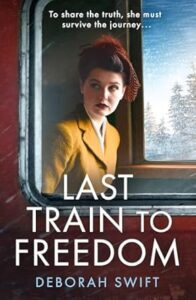
This gripping historical novel invites reading group members into the perilous realm of World War II, where two siblings must flee persecution from Soviet forces in Lithuania. Through thoughtful book club discussions, fellow readers will find themselves caught up in a high-stakes journey aboard the Trans-Siberian Railway, where desperate escapees risk everything in search of freedom. This remarkable book explores profound themes of sacrifice, identity and the indomitable human spirit against a meticulously researched historical backdrop.
BUY THE BOOK FROM HARPER COLLINS and Learn MoreBook Club QuestionsHow does the author use the Trans-Siberian railway journey as both a literal and metaphorical device throughout the novel? What does the train represent?Explore the complex relationship between siblings Zofia and Jacek. How does their bond influence their choices and actions?Several characters in the novel are not what they initially seem. How does the author build suspense around their true identities and motivations?What role does Otto play in the story? How does his character development reflect larger themes about moral choices during wartime?Discuss the significance of documents and paperwork in the novel. How do they represent both hope and danger for the characters?How does the author portray the different faces of resistance and collaboration during this period?What role does identity play in the novel? How do characters hide, change, or maintain their sense of self?Consider the cultural differences portrayed in the novel. How do characters navigate these barriers?How does the author build and maintain tension throughout the railway journey?Discuss the difficult choices characters must make. What would you have done in their situations?How does the novel explore themes of loyalty and betrayal? Which characters stay true to their principles?What role do small acts of kindness play throughout the story? How do they contrast with larger acts of cruelty?Discuss the portrayal of the Jewish refugee experience. How does the author bring this historical reality to life?What does the novel suggest about the nature of survival? What different strategies do characters employ?How does the ending resonate with the themes established throughout the book? What questions remain unresolved?
BUY THE BOOK HERE on Kindle , or read on KindleUnlimited.
The post Book Club Questions for Last Train to Freedom by Deborah Swift #ReadingGroup #BookClub first appeared on Deborah Swift.
Writing The Legend and History of Giulia Tofana by Deborah Swift #GiuliaTofana #HistoricalFiction
When I first had the idea to write about Giulia Tofana, all I knew about her was that she’d killed 600 men in Renaissance Italy. Immediately it made me curious to know why, and what sort of a woman she might be. I wondered whether she was really as murderous as the claims made out, and what I could discover about her by researching her life. I was also attracted to the Italian Renaissance setting and thought it would be fantastic to write a book about her. But if she was such a great subject, why had nobody else done it first?
 A Poison Ring From The Wellcome Trust (wikicommons)Aqua Tofana
A Poison Ring From The Wellcome Trust (wikicommons)Aqua TofanaI soon discovered why. Of the real historical woman there are few traces in any contemporary record and in fact there are more mentions of the poison she invented than the actual person. Many references to her were from the Victorian era, hundreds of years after her death. Rumours abounded about the use of poison rings (see real example of gold hinged snake ring above) and her liquid poison Aqua Tofana.
I also discovered that she was in fact three people, not only one. Her mother and daughter were both often confused with her, and I soon realized I was dealing with three generations of poisoners. That explained all the conflicting dates I was coming across as I delved into the research. The mother, Theofania d’Adamo was executed for her crimes in 1633. The daughter, Girolama Spara, was also executed but sometime later in the 18th Century. So what happened to the middle generation – Giulia Tofana, after whom the famous poison Aqua Tofana is named?
The answer is, nobody knows. So I had a situation a little like writing about King Arthur – we know she existed, but much of her life is rumour or hearsay. What we can be certain of, is that she mattered, because her name has lasted all this time, and her deeds must have had an impact for her notoriety to have spread.
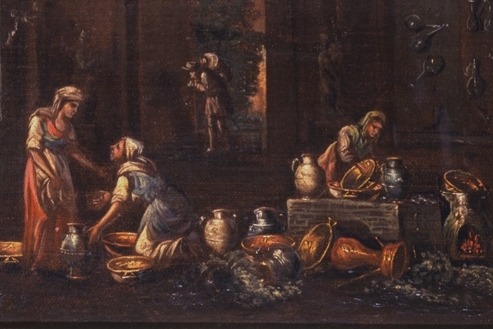
I gradually unpicked the real history, and used much of it in the novel, including her mother’s death. Where no real event existed, I invented or embroidered using research into Italian apothecary practices of the time. What makes the novel historical rather than fantasy is this adherence to known facts and also the attention to detail with the setting and the reality of life in Naples at the time she was alive.
I read through eyewitness accounts of women of the time from letters and diaries. These were hard to find as they had to be in translation, but academic websites such as Academia and JStor supplied me with papers on life in Naples at the time.
Maps were a huge source of interest for me. Giulia and her mother begin life in Palermo, which is now in Sicily, but Giulia has to go on the run to Naples. Most of Italy was under Spanish control at this time. I made use of the old maps which supplied me with the geography and street names, and also places of importance such as churches, markets or the docks.

Because Giulia Tofana is a legend, within the book I needed to show that she mattered and was famous within her own time and that her deeds impacted on the lives around her, especially those of the women. So she had to not only be fascinating to us as readers but also fascinating to people within her own world. This was a challenge, but poison itself is surrounded by plant lore, by ritual, and by mystery, so the subject matter lent itself to a certain amount of myth.
Even today, nobody knows the ingredients of Aqua Tofana, or why it was so deadly. This left me considerable leeway within the book, and I hope I’ve made the most of it.
New Facts about Giulia TofanaSince writing this book in 2021, more evidence about her life has come to light – discovered in the depths of the Vatican library. Some of this evidence conflicts with the previous sources I used for the books. Of course I can do nothing about this. Re-writing the books would be impossible – and besides, there may be more and different evidence yet to be found. What I can do, is incorporate the new evidence into any future books, and continue to take an interest and keep informed about how her life and legend are still subject to development even today.
 Naples 1633
Naples 1633
Aqua Tofana – One drop to heal. Three drops to kill.
Giulia Tofana longs for more responsibility in her mother’s apothecary business, but Mamma has always been secretive and refuses to tell Giulia the hidden keys to her success. When Mamma is arrested for the poisoning of the powerful Duke de Verdi, Giulia is shocked to uncover the darker side of her trade.
Giulia must run for her life, and escapes to Naples, under the shadow of Mount Vesuvius, to the home of her Aunt Isabetta, a famous courtesan. But when Giulia hears that her mother has been executed, and the cruel manner of her death, she swears she will wreak revenge on the Duke de Verdi.
The trouble is, Naples is in the grip of Domenico, the Duke’s brother, who controls the city with the ‘Camorra’, the mafia. Worse, her Aunt Isabetta, under Domenico’s thrall, insists that she should be consort to him – the brother of the man she has vowed to kill.
Based on the legendary life of Italian poisoner Giulia Tofana, this is a story of hidden family secrets, and how even the darkest desires can be vanquished by courage and love.
The post Writing The Legend and History of Giulia Tofana by Deborah Swift #GiuliaTofana #HistoricalFiction first appeared on Deborah Swift.July 10, 2025
Unspoken by Jann Alexander #Texas #CoffeePotBookClub #Dustbowl #1930s
A Farm Devastated. A Dream Destroyed. A Family Scattered.
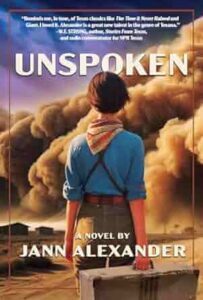
Deborah’s Review“Reminds me, in tone, of Texas classics like The Time it Never Rained and Giant. I loved it. Alexander is a great new talent in the genre of Texana.” -W.F. Strong, author, Stories From Texas, and radio commentator for NPR Texas
I received a copy of this novel for review via NetGalley.
A thoroughly enjoyable and well-researched historical novel set in the Dust Bowl years in Texas and beyond. Told from the points of view of Ruby Lee and her mother Willa Mae., the novel portrays the hardscrabble life lived by many in the US in the depression, and the effects of drought and deprivation on working people. It also shows us in gripping detail what institutions were like in the 1930s – the portrayals of the orphanage and asylum are poignant and make you shudder.
Ruby Lee is written in an engaging vernacular style, as are her companions on this journey which takes her from being an innocent ten year old to being an adult shaped by her tough experiences. She’s a character you can root for, and the reader wills her to succeed. Her mother Willa Mae is sensitively drawn as a woman whose mind is affected not only by the devastating loss of her family and home, but also by the treatment she must endure in the asylum. – the freezing baths and electric shock treatment.
Historical fiction readers will appreciate the attention to detail, the overalls and aprons hung on the lines by the railroad, the way the children in the orphanage were lined up in sailor suits to have their sham photograph taken, Willa Mae’s memories of the smell of the glove factory. This is a novel for the reader to savour small details that conjure a different time and place.
Although she has a constant longing for home, Ruby Lee develops her own version of morality and resourcefulness as she navigates being dealt the short straw in life. The novel is a wonderful slice of Americana with a heroine to take to your heart, and I highly recommend it.
Connect with Jann
Jann Alexander is an artist photographer and novelist. Her stunning photography features Vanishing Austin, Mother Earth, and Texana, and the Journey into the American southwest and Mexico, along the Mission Trail.
watch The Trailer visit JannAlexander.com follow @JannAlexTX connect on Facebook
The post Unspoken by Jann Alexander #Texas #CoffeePotBookClub #Dustbowl #1930s first appeared on Deborah Swift.July 6, 2025
By Love Divided by Elizabeth St John #CoffeePotBookClub #LydiardChronicles
By Love Divided is the second of the Lydiard Chronicles and wow, what a pageturner it is. I am so surprised that more is not made of the English Civil Wars in books and films. This book exemplifies the themes of this massive period of change and shows the toll it took on the nation of England. Thoroughly convincing and painstakingly researched from documents of the time – these were real people and Elizabeth St John tells their heart-wrenching story with grace and depth. When the Apsley family are left in penury by the death of Lucy’s husband, survival is not easy. His debts are enormous and caused by his recent support for the Duke of Buckingham’s campaigns. Petitions fail, and Lucy must seek other means of survival for herself and her young adult children. Enter Leventhorpe Franke, A Puritan who is intent on helping her regain her fortune – for his own benefit.
From there, the war between the King and Parliament spirals into bloodshed, and Lucy’s family riven by bitter differences of opinion. Lucy’s children find themselves on opposing sides of the divide. Her daughter Luce Hutchinson – well-known for her real-life memoirs about the English Civil Wars (Parliamentarian) and her son Allen (Royalist) cannot agree and this bitter divide threatens to tear the family apart.
The horrors of war – bloodshed, betrayal and grief, (yes we see some of these in their visceral horror) are countered by intimate moments where you feel the bonds between the characters, and it is these small moments against the backdrop of huge events that keep the reader glued to the pages. The love story between Luce and John is tender, especially when her life is threatened by smallpox, and although I’d read about John Hutchinson in history books, meeting the living breathing man was a true eye-opener. Allen, who I disliked at the beginning grew in stature and by the end I was uncertain whose side I was on. This is the mark of a great novel that the characters develop and change, and make you question yourself and all your firmly held beliefs.
This is a wonderful, moving portrait of the age in which civil war tore England in two. Five stars plus!
Go and Buy – This is the second book in the series, I recommend you start with the first.
Here’s the link
Universal Series Link This series is available to read on #KindleUnlimited.By Love DividedAbout Elizabeth St.John Elizabeth St.John’s critically acclaimed historical fiction novels tell the stories of her ancestors: extraordinary women whose intriguing kinship with England’s kings and queens brings an intimately unique perspective to Medieval, Tudor, and Stuart times.Inspired by family archives and residences from Lydiard Park to the Tower of London, Elizabeth spends much of her time exploring ancestral portraits, diaries, and lost gardens. And encountering the occasional ghost. But that’s another story.Living between California, England, and the past, Elizabeth is the International Ambassador for The Friends of Lydiard Park, an English charity dedicated to conserving and enhancing this beautiful centuries-old country house and park. As a curator for The Lydiard Archives, she is constantly looking for an undiscovered treasure to inspire her next novel.Elizabeth’s works include The Lydiard Chronicles, a family saga set in 17th-century England during the Civil War, and The Godmother’s Secret, which unravels the medieval mystery of the missing princes in the Tower of London. Her latest release, The King’s Intelligencer, follows Franny Apsley in the treacherous court of Charles II as she risks everything to uncover the dangerous truth behind the discovery of the princes’ bones.Author Links:Website • Facebook • Bluesky • Threads • InstagramAmazon Author Page • BookBub • LinkedIn • Goodreads
Elizabeth St.John’s critically acclaimed historical fiction novels tell the stories of her ancestors: extraordinary women whose intriguing kinship with England’s kings and queens brings an intimately unique perspective to Medieval, Tudor, and Stuart times.Inspired by family archives and residences from Lydiard Park to the Tower of London, Elizabeth spends much of her time exploring ancestral portraits, diaries, and lost gardens. And encountering the occasional ghost. But that’s another story.Living between California, England, and the past, Elizabeth is the International Ambassador for The Friends of Lydiard Park, an English charity dedicated to conserving and enhancing this beautiful centuries-old country house and park. As a curator for The Lydiard Archives, she is constantly looking for an undiscovered treasure to inspire her next novel.Elizabeth’s works include The Lydiard Chronicles, a family saga set in 17th-century England during the Civil War, and The Godmother’s Secret, which unravels the medieval mystery of the missing princes in the Tower of London. Her latest release, The King’s Intelligencer, follows Franny Apsley in the treacherous court of Charles II as she risks everything to uncover the dangerous truth behind the discovery of the princes’ bones.Author Links:Website • Facebook • Bluesky • Threads • InstagramAmazon Author Page • BookBub • LinkedIn • Goodreads

July 2, 2025
The Antidotes to 17th Century Poison by Deborah Swift #GiuliaTofana #Poisoner
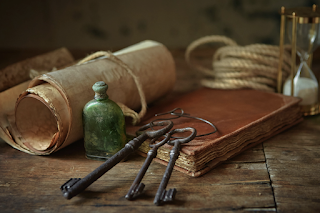 You are a man living in Naples in the 17th Century and you suspect your wife might be poisoning you. Surprisingly, this is not uncommon. Many men of your own age (late fifties) have died in mysterious circumstances, leaving their young wives, many under twenty years old, to inherit their whole estates. So what steps can you take to make sure you don’t meet the same fate?
You are a man living in Naples in the 17th Century and you suspect your wife might be poisoning you. Surprisingly, this is not uncommon. Many men of your own age (late fifties) have died in mysterious circumstances, leaving their young wives, many under twenty years old, to inherit their whole estates. So what steps can you take to make sure you don’t meet the same fate?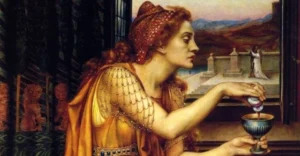 This was the question that the Duke de Verdi in my novel The Poison Keeper was asking, and an answer I had to research. The first thing men did was always to get food and drinks tested, and so many aristocratic men employed a ‘taster’ who would try all their food an hour before it was served. This was a well-paid position and one that although dangerous was popular amongst the poor of Naples when harvests failed or they had no other way of earning a living. Naturally the ‘taster’ also kept herbal remedies nearby in case of ‘accidents.’ One of these remedies was raw charcoal, which has since been proved to be able to absorb liquid poison in the gut, and although not foolproof might give the victim more of a chance of survival.
This was the question that the Duke de Verdi in my novel The Poison Keeper was asking, and an answer I had to research. The first thing men did was always to get food and drinks tested, and so many aristocratic men employed a ‘taster’ who would try all their food an hour before it was served. This was a well-paid position and one that although dangerous was popular amongst the poor of Naples when harvests failed or they had no other way of earning a living. Naturally the ‘taster’ also kept herbal remedies nearby in case of ‘accidents.’ One of these remedies was raw charcoal, which has since been proved to be able to absorb liquid poison in the gut, and although not foolproof might give the victim more of a chance of survival.
 The colourless liquid Aqua Tofana, invented by Giulia Tofana in 17th Century Naples, was a slow-acting poison, and the early symptoms could appear to be a digestive problem or mild illness. The symptoms recorded suggest arsenic poisoning, and it is widely believed that arsenic and belladonna were two of the main ingredients. The first small dosage would produce cold or flu-like symptoms. But by the third dose the victim would be vomiting, and really ill and death would follow shortly after. The antidote that was common at that time was a simple digestive remedy of vinegar and lemon juice, a solution that becomes alkaline when ingested. This would have done little to counteract the effects of arsenic and belladonna, and indeed there is little one can do to protect against systemic poisoning.
The colourless liquid Aqua Tofana, invented by Giulia Tofana in 17th Century Naples, was a slow-acting poison, and the early symptoms could appear to be a digestive problem or mild illness. The symptoms recorded suggest arsenic poisoning, and it is widely believed that arsenic and belladonna were two of the main ingredients. The first small dosage would produce cold or flu-like symptoms. But by the third dose the victim would be vomiting, and really ill and death would follow shortly after. The antidote that was common at that time was a simple digestive remedy of vinegar and lemon juice, a solution that becomes alkaline when ingested. This would have done little to counteract the effects of arsenic and belladonna, and indeed there is little one can do to protect against systemic poisoning.
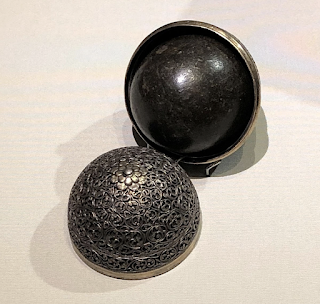 Bezoar StonesMany aristocratic men purchased Bezoar Stones which were supposed to protect against poison. Bezoars have been used for many centuries as antidotes. The stone is a solid mass like a solidified hairball found in the digestive tracts of animals, including deer, yaks, and even fish. These were often set into a jewelled or elaborate mount, and the idea was you would grind these into your food or wine and by some sort of magic it would remove the taint of poison. Sounds Bizarre? Yes, but in 1998, a study on bezoar stones proved they were effective in removing arsenic from a solution. Bezoar stones are comprised of both the mineral brushite and degraded hair. Arsenic apparently binds with the sulphur compounds found in proteins of degraded hair.
Bezoar StonesMany aristocratic men purchased Bezoar Stones which were supposed to protect against poison. Bezoars have been used for many centuries as antidotes. The stone is a solid mass like a solidified hairball found in the digestive tracts of animals, including deer, yaks, and even fish. These were often set into a jewelled or elaborate mount, and the idea was you would grind these into your food or wine and by some sort of magic it would remove the taint of poison. Sounds Bizarre? Yes, but in 1998, a study on bezoar stones proved they were effective in removing arsenic from a solution. Bezoar stones are comprised of both the mineral brushite and degraded hair. Arsenic apparently binds with the sulphur compounds found in proteins of degraded hair.
 Making Venice TreacleVenice Treacle, sometimes called Theriac, (from the Greek therion – viper) was an herbal remedy invented by Emperor Nero’s physician. It was later produced in Italy in full public view in a special ceremony, because the public wanted to be sure it wasn’t adulterated with anything that shouldn’t be there. In fact Venice Treacle consisted of more than seventy ingredients, some of which were dubious to say the least. It included benign elements like cinnamon, lavender and honey, but also included opium and even snake venom. In the 17th Century there was the idea that like could cure like. The long and complex list of ingredients made it unlikely anyone would try to make it at home, and so it became a kind of cure-all for everything from poison to the plague.The fact that there was a lack of a definitive cure for poison meant that during Giulia Tofana’s stay in Rome over 600 men died. Whether all of them were a result of her poison, Aqua Tofana, or some died of natural causes, we will never know.The post The Antidotes to 17th Century Poison by Deborah Swift #GiuliaTofana #Poisoner first appeared on Deborah Swift.
Making Venice TreacleVenice Treacle, sometimes called Theriac, (from the Greek therion – viper) was an herbal remedy invented by Emperor Nero’s physician. It was later produced in Italy in full public view in a special ceremony, because the public wanted to be sure it wasn’t adulterated with anything that shouldn’t be there. In fact Venice Treacle consisted of more than seventy ingredients, some of which were dubious to say the least. It included benign elements like cinnamon, lavender and honey, but also included opium and even snake venom. In the 17th Century there was the idea that like could cure like. The long and complex list of ingredients made it unlikely anyone would try to make it at home, and so it became a kind of cure-all for everything from poison to the plague.The fact that there was a lack of a definitive cure for poison meant that during Giulia Tofana’s stay in Rome over 600 men died. Whether all of them were a result of her poison, Aqua Tofana, or some died of natural causes, we will never know.The post The Antidotes to 17th Century Poison by Deborah Swift #GiuliaTofana #Poisoner first appeared on Deborah Swift.



